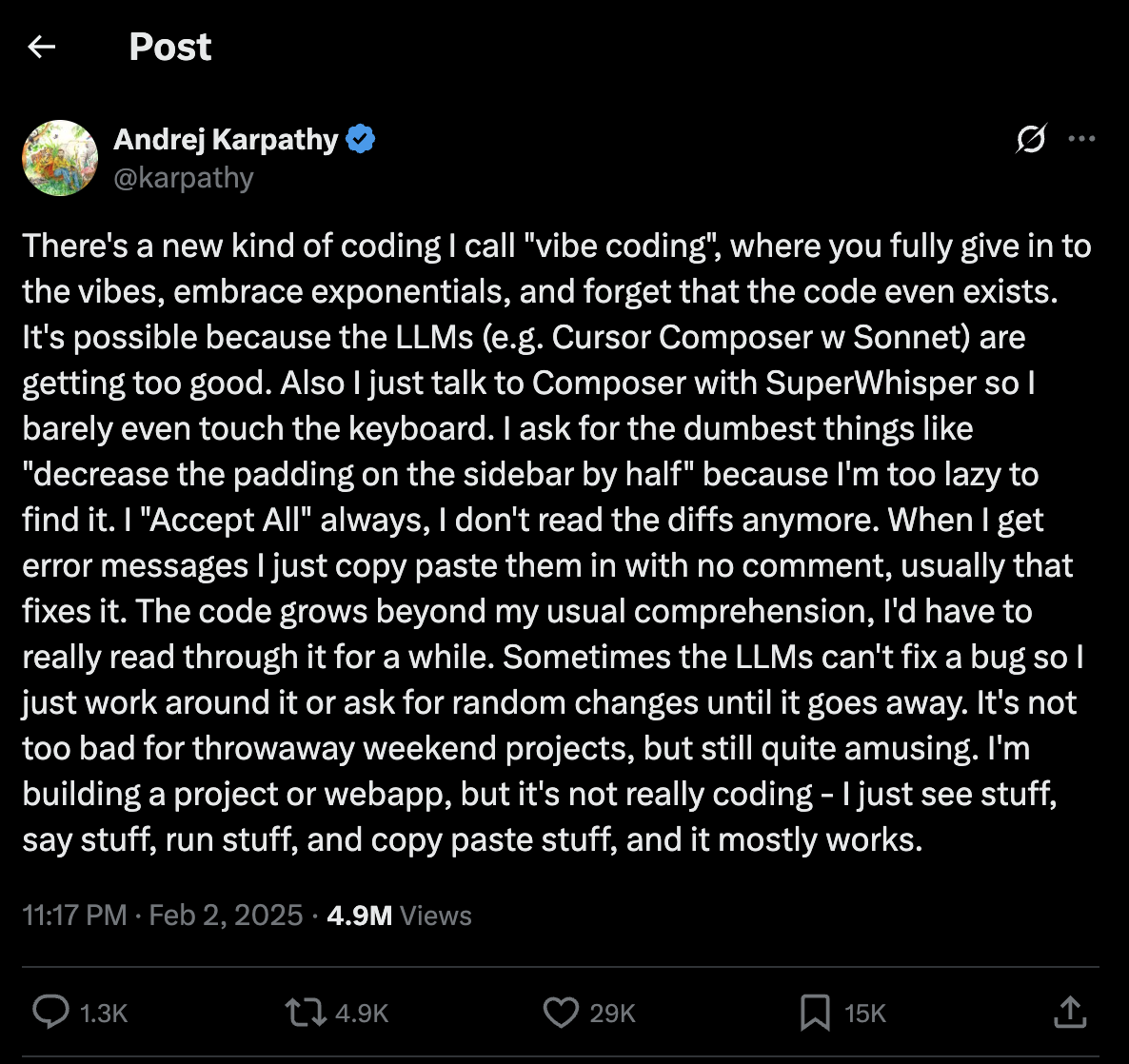Few concepts have captured the imagination of developers and non-developers alike as quickly as "vibe coding" — a term that went from obscure jargon to mainstream awareness in a matter of months.
01The Origin of Vibe Coding
The term "vibe coding" was coined by OpenAI co-founder and AI researcher Andrej Karpathy in a now-famous tweet posted on February 2, 2025. In this tweet, Karpathy described a new approach to programming that leveraged advanced AI tools to radically transform the development process.

In his tweet, Karpathy described vibe coding as a process where you "fully give in to the vibes, embrace exponentials, and forget that the code even exists." He noted that this approach was made possible by increasingly capable large language models (LLMs) like Cursor Composer with Claude Sonnet 3.5, which could generate and modify code based on natural language instructions.
What started as a casual observation quickly resonated with developers worldwide. By March 2025, just one month after Karpathy's tweet, Merriam-Webster had listed "vibe coding" as a trending slang term, and the concept began appearing in mainstream tech publications.
02Rapid Mainstream Adoption
The rapid adoption of vibe coding has been nothing short of remarkable. By early 2025, the term had achieved mainstream awareness, driven by several key factors:
- High-profile endorsements: Following Karpathy's initial tweet, several influential tech leaders and organizations publicly embraced the concept.
- Media coverage: Major publications including the New York Times and TechCrunch ran feature articles on vibe coding, bringing the concept to a broader audience.
- Startup adoption: Approximately 25% of Y Combinator's Winter 2025 cohort reportedly used AI-generated codebases aligned with vibe coding principles.
- Viral social media: Developers sharing their experiences with vibe coding created a viral effect across platforms like Twitter, GitHub, and Discord.
03What Makes Vibe Coding Different?
At its core, vibe coding represents a fundamental shift in how developers approach software creation. Traditional coding requires developers to:
Traditional Coding
- Understand programming language syntax and semantics
- Manually write code line by line
- Debug issues through careful analysis
- Maintain a comprehensive mental model of the codebase
Vibe Coding Approach
- Communicate desired outcomes in natural language
- Allow AI to generate and modify code
- Provide feedback and refinement through conversation
- Focus on results rather than the underlying code
As Karpathy noted in his original tweet, this approach often means that "the code grows beyond my usual comprehension" — but for many use cases, particularly rapid prototyping and personal projects, the results are remarkably effective.
04The Broader "Vibe [X]" Paradigm
The success of vibe coding has sparked a broader "Vibe [X]" paradigm that's expanding into other creative and technical domains. Two notable examples include:
Vibe Marketing
Vibe marketing has emerged as a parallel concept, leveraging AI to automate campaign creation, analyze competitor strategies, and generate emotionally resonant content. Modern tools now enable marketers to launch campaigns in days instead of weeks, with AI handling execution while humans define brand "vibes" and strategic direction.
This approach has been particularly effective for small businesses and startups that previously lacked the resources for comprehensive marketing campaigns. By describing the desired brand feeling and target audience, these organizations can now generate professional-quality marketing materials without specialized design or copywriting skills.
Vibe Design
Vibe design integrates AI into UX workflows, allowing designers to create functional prototypes through natural language prompts and iterate dynamically based on user feedback. This approach blurs traditional boundaries between design and development roles.
Designers can now describe interfaces, interactions, and animations in natural language, and see them rendered in real-time. This has dramatically accelerated the prototyping process and enabled more rapid iteration based on user feedback.
05Criticisms and Limitations
Despite its rapid adoption, vibe coding is not without critics. Common concerns include:
- Code quality and maintainability: AI-generated code may be functional but not always optimal or maintainable in the long term.
- Security vulnerabilities: Without proper oversight, AI might introduce security flaws that human developers would catch.
- Dependency on AI providers: Vibe coding creates reliance on the companies providing the AI tools, raising concerns about vendor lock-in.
- Skill atrophy: Some worry that developers might lose fundamental coding skills if they rely too heavily on AI assistance.
These concerns are valid, particularly for mission-critical applications or large-scale production systems. However, proponents argue that vibe coding is best viewed as another tool in the developer's toolkit rather than a complete replacement for traditional coding skills.
06The Future of Vibe Coding
As AI models continue to improve, the capabilities and applications of vibe coding are likely to expand. Some trends to watch include:
Tools optimized for specific domains like game development, data science, or web applications.
Better integration between AI assistants and human teams, allowing for more seamless collaboration.
Using vibe coding as an entry point to teach programming concepts to beginners.
Larger organizations developing governance and best practices for incorporating vibe coding into professional workflows.
At Vibe Club, we believe that vibe coding is a transformative technology that makes coding and digital creation accessible to almost anyone with an idea and a curious mind. The sort of 21st century skills that vibe coding develops - such as creativity, problem-solving and curiosity - are exactly the skills that employers are rewarding.
Learn More About Vibe Coding
Ready to dive deeper into vibe coding? Explore our tutorials, glossary, and project showcases to see vibe coding in action.
Related Articles
The Rise of Vibe Marketing
How AI is transforming marketing campaigns and enabling emotionally resonant content creation at scale.
Coming Soon
Vibe Design: The New UX Paradigm
Exploring how AI is blurring the lines between design and development through natural language interfaces.
Coming Soon
The Future of Education with Vibe Coding
How vibe coding is democratizing computer science education and transforming learning outcomes.
Coming Soon
